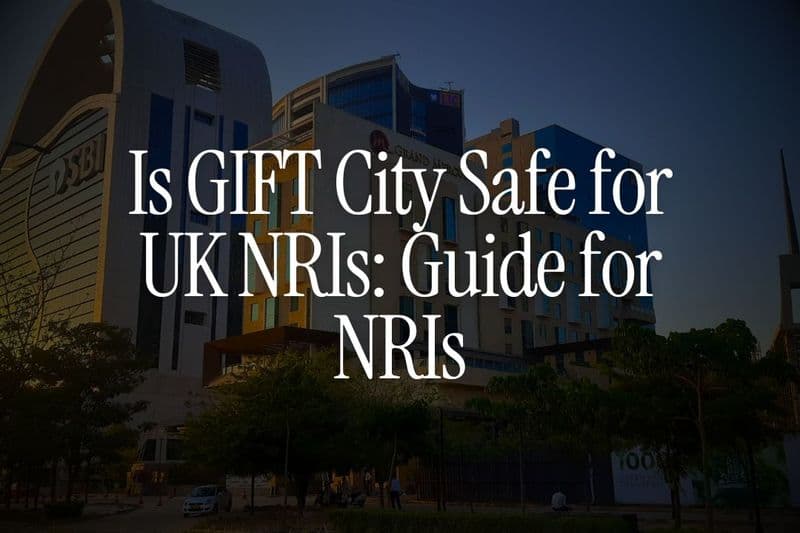
Picture this: you're 45, sitting in your Dubai apartment after another long workday. You've saved well over the years. Retiring early in India, close to family and familiar food, keeps pulling at you.
But the questions won’t stop.
Is my UAE savings enough? What about healthcare costs?
Will taxes eat into my retirement? Can I maintain my lifestyle?
You're not alone.
At Belong, we meet NRIs in the UAE at this exact crossroads. They've built savings in dirhams and dollars and want to know if those savings can power an early retirement back home.
Good news: with a plan, it’s possible.
Bad news: without grasping the numbers, tax rules, and hidden costs, money can drain faster than you expect.
This guide covers the math, RNOR rules, where to live, and how to turn savings into steady income. We’ll also show how GIFT City USD fixed deposits can reduce rupee depreciation risk while offering tax-efficient returns.
If early retirement is on your mind, this walkthrough will help you make solid decisions.
How Much Money Do You Really Need to Retire in India?
There isn't a single number for everyone.
Your corpus depends on lifestyle, city, and how long the money must last.
For a comfortable urban life, many couples aim for ₹2–3 crore and ₹1–1.5 lakh per month in Tier-1 cities like Bengaluru, Mumbai, or Delhi. (*Guidance number - validate with your own budget.)
In smaller cities, ₹3–4 crore may be enough. In high-cost metros, you might need ₹7–8 crore. (*Guidance ranges, not a single dataset.)
A quick sketch:
Age 45 now, retire at 50, plan till 85.
That’s 35 years of expenses.
If monthly costs are ₹1 lakh (₹12 lakh yearly) and you model ~6% inflation, the target corpus often lands near ₹4–5 crore. (*Model-dependent - run your own calculator.)
Healthcare inflation tends to run hotter than headline inflation in India, with industry trackers showing low double digits in recent years Source.
👉 Tip: Use Belong’s Residential Status Calculator to confirm your tax status, then work backward to your real target corpus.
Plan for lifestyle creep too. ₹1 lakh a month today can feel like ~₹1.8 lakh in 10 years at 6% inflation.
A common savings model uses:
Future Value = Current Savings × (1 + Return Rate)^Years + Annual Savings × [((1 + Return Rate)^Years − 1) / Return Rate]
Start with a monthly number you can defend. Multiply by 12. Inflate for 30–35 years. Add a buffer for shocks.
Your Tax Status Can Save You Lakhs: Understanding RNOR
After moving back, you may qualify for RNOR (Resident but Not Ordinarily Resident) if either condition is true:
Non-resident in 9 of the 10 preceding financial years, or
Stayed in India for 729 days or less during the 7 preceding financial years
Source
During RNOR, India generally taxes only income received or accruing in India. Most foreign income stays outside Indian tax in this window Source.
The RNOR period often works out to about 3 years (checked year by year). Use it to clean up overseas holdings and restructure cash flows Source.
Common items that remain outside Indian tax for RNORs: interest from foreign bank accounts, capital gains on foreign assets, rental income from property abroad, and dividends from international stocks (subject to specific rules) Source.
Returning NRIs can keep RFC deposits. Interest on RFC or existing FCNR deposits is exempt while you are RNOR under Section 10(15)(iv)(fa) Source Source.
👉 Tip: Time your arrival. Landing late in the financial year can help stretch the RNOR window for some profiles.
The Real Cost of Living: UAE vs India (Updated 2025)
Numbers you can benchmark:
Country level: cost of living including rent in India is roughly 74 – 75% lower than the UAE Source.
City level: Dubai’s cost of living including rent is about 290% higher than Delhi’s on Numbeo’s index set Source.
Housing:
- AED 6,000–8,000 for a 2BHK in Dubai vs ₹30,000 – 50,000 in many Tier-1 Indian areas aligns with index data bands Source.
Ranges swing by neighborhood.
Transport and utilities:
Fuel in India hovers near ₹100 per liter and varies by state.
Power bills with AC use can run ₹5,000–15,000 in metros.
Rideshares are cheaper than Dubai taxis, but still part of the budget.
For an NRI couple in Bengaluru or Mumbai, ₹12–14 lakh a year is a workable planning anchor. (*Rule-of-thumb - build your own sheet.)
👉 Tip: Track 6 months of UAE spend, map it to Indian equivalents, add a 20% buffer.
Healthcare: The Elephant in the Room
Medical trend in India has outpaced CPI in recent years Source.
Premiums:
Family cover under 60: often ₹50,000–1,00,000 per year.
By 70: can reach ₹1.5–2 lakh depending on cover and health.
Source Source
Practical moves:
Buy health insurance before you return. Waiting periods (2–4 years) on pre-existing conditions are common, so start the clock early Source.
Expect premium jumps with age.
Keep a separate medical fund of ₹10–15 lakh. (*Guideline, not a hard rule.)
Look at senior citizen plans for aging parents Source.
Where Should You Retire in India?
Tier-1 cities offer stronger healthcare, connectivity, and social options, with higher annual costs (often ₹12–15 lakh). Tier-2 cities can be 30–40% lower (₹8–10 lakh). (*Heuristics - check your short-list city.)
Retirement communities like Ashiana, Covai, and Columbia Pacific exist. Visit, check healthcare tie-ups, and study maintenance terms before you commit.
Try a 2–3 month stay in shortlisted cities. Rent, use local hospitals, and talk to other returnees.
👉 Tip: Join Belong’s WhatsApp Community and ask people who’ve already moved.
Creating Retirement Income: Your Money Needs to Work
Cash loses buying power when inflation beats savings rates.
Fixed Deposits
NRE/NRO FD rates often sit around 6.5–7.5% depending on bank and tenor Source Source.
DICGC covers ₹5 lakh per depositor per bank Source.
GIFT City USD Fixed Deposits
IFSC banks can offer USD deposits to NRIs with India-side tax efficiencies under specified sections and USD exposure that reduces INR depreciation risk. Bank terms and tax handling vary by product. Confirm TDS and exemptions with your CA Source Source Source.
Historically, INR weakened against USD over 2015–2025. Future FX can differ, so treat this as diversification, not a sure thing Source.
👉 Tip: Ladder maturities so you don’t break FDs for cash needs.
Debt Mutual Funds
Potentially higher than FD yields, with market risk. Tax rules depend on holding period and fund type.
Monthly Income and Annuities
Predictable cash flow, lower real returns, and inflation drag. Compare post-tax, post-inflation results.
Equity Exposure
With a 30-40 year horizon, a 20–30% equity sleeve in large-cap or balanced funds can help growth. Don’t park money in equity you’ll need in the next 5–7 years.
Rental Income
Useful for diversification, but account for vacancies, upkeep, and concentration risk.
Sample split for ₹5 crore (illustrative only):
40% GIFT City USD FDs
30% INR FDs or debt funds
20% balanced or large-cap equity funds
10% liquid or emergency fund
The Repatriation Question: Can You Move Money Back If Needed?
NRE funds: fully repatriable, principal and interest Source.
NRO funds: up to USD 1 million per financial year with Form 15CA/CB and documentation Source Source Source.
GIFT City USD deposits: typically repatriable as offshore IFSC accounts (check your bank’s T\&Cs).
After status change to resident: outward money is via LRS with limits and paperwork.
Keep RFC accounts after return if you need foreign currency flexibility. RFC interest is exempt while RNOR Source.
Tax Planning for Early Retirement: Keep More of Your Money
During RNOR
Realize foreign income and assets while RNOR, since they’re generally outside Indian tax for RNORs Source.
Use eligible deductions where they apply.
PPF note: NRIs cannot open new PPF accounts, but existing PPFs can be kept till maturity.
After You Become Resident
Listed equity/equity MF LTCG exemption rose to ₹1.25 lakh per year from FY 2024–25 Source Source.
Section 80D: ₹25,000 deduction for self/family, plus ₹25,000 for parents (₹50,000 if senior). Max can touch ₹1,00,000 when both assessee and parents are seniors Source Source.
New tax regime is the default from FY 2023–24 under Section 115BAC(1A), but you can opt for the old regime if it suits you Source Source.
Common Mistakes That Can Wreck Early Retirement
Underestimating healthcare costs. Medical trend can run 12–14% Source.
Converting everything to INR at once. INR weakened vs USD over 2015–2025, so keep some USD exposure Source.
Ignoring inflation in your model.
Lifestyle creep.
Saying yes to every family ask.
All-in on real estate.
Under-planning longevity.
Not preparing your spouse for the plan.
Your Step-by-Step Action Plan for Early Retirement
6–12 Months Before Moving
Month 1–2: track UAE spend, map to Indian costs, add 20%, estimate corpus.
Month 3–4: check RNOR with Belong’s calculator.
Month 5–6: buy health cover as NRI and start waiting periods.
Month 7–8: plan taxes, consider RFC, decide what to close or keep.
Month 9–10: scout cities, test healthcare and daily life.
Month 11–12: set up income streams, including a USD sleeve via GIFT City and INR liquidity.
First Year After Moving
Month 1–3: convert accounts where required, update KYC, file taxes, join local groups.
Month 4–6: compare real spend vs plan, adjust.
Month 7–12: build medical relationships, settle housing, rebalance portfolio.
Annual Reviews
Re-check corpus vs spend, update insurance, rebalance, refresh wills and nominations, confirm residential status.
Real Example: How Ramesh and Priya Did It
Illustrative case.
Savings: ~₹7 crore.
Coimbatore target spend: ₹10–12 lakh yearly.
RNOR qualified.
Split: USD FDs in GIFT City, INR FDs and debt funds, equity sleeve, and a medical buffer.
Three years later, they report stable cash flow and a growing corpus, thanks to discipline and right-sized risk.
Can You Do It?
Yes, with honest math and steady habits.
Set a realistic, inflation-aware monthly number.
Use RNOR smartly.
Insure well and ring-fence a medical fund.
Diversify across INR and USD, debt and equity.
Create multiple income streams.
Keep liquidity for shocks.
Review every year.
Note on the 4% rule: it’s a US heuristic. Treat 4% as a starting point, then adapt to India’s inflation, taxes, and your risk Source.
Belong can help with tools like FD rate comparison, residential status calculator, and compliance compass, plus GIFT City USD options.
Join our WhatsApp Community to learn from others on the path. Get the Belong App to explore investments and track your FDs.




